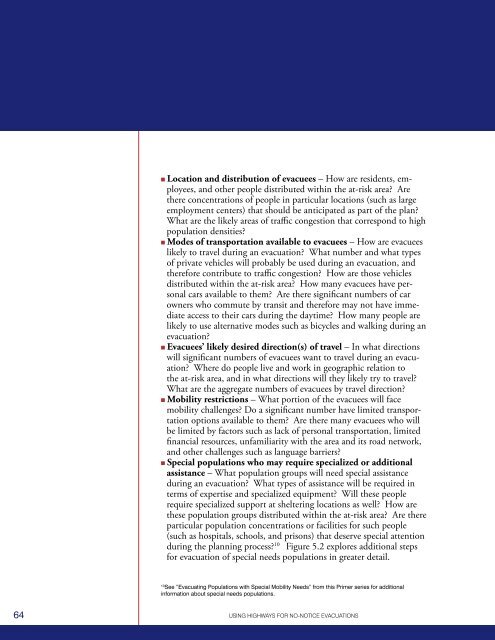using highways for no-notice evacuations - FHWA Operations - U.S. ...
using highways for no-notice evacuations - FHWA Operations - U.S. ...
using highways for no-notice evacuations - FHWA Operations - U.S. ...
Create successful ePaper yourself
Turn your PDF publications into a flip-book with our unique Google optimized e-Paper software.
n Location and distribution of evacuees – How are residents, employees,and other people distributed within the at-risk area? Arethere concentrations of people in particular locations (such as largeemployment centers) that should be anticipated as part of the plan?What are the likely areas of traffic congestion that correspond to highpopulation densities?n Modes of transportation available to evacuees – How are evacueeslikely to travel during an evacuation? What number and what typesof private vehicles will probably be used during an evacuation, andthere<strong>for</strong>e contribute to traffic congestion? How are those vehiclesdistributed within the at-risk area? How many evacuees have personalcars available to them? Are there significant numbers of carowners who commute by transit and there<strong>for</strong>e may <strong>no</strong>t have immediateaccess to their cars during the daytime? How many people arelikely to use alternative modes such as bicycles and walking during anevacuation?n Evacuees’ likely desired direction(s) of travel – In what directionswill significant numbers of evacuees want to travel during an evacuation?Where do people live and work in geographic relation tothe at-risk area, and in what directions will they likely try to travel?What are the aggregate numbers of evacuees by travel direction?n Mobility restrictions – What portion of the evacuees will facemobility challenges? Do a significant number have limited transportatio<strong>no</strong>ptions available to them? Are there many evacuees who willbe limited by factors such as lack of personal transportation, limitedfinancial resources, unfamiliarity with the area and its road network,and other challenges such as language barriers?n Special populations who may require specialized or additionalassistance – What population groups will need special assistanceduring an evacuation? What types of assistance will be required interms of expertise and specialized equipment? Will these peoplerequire specialized support at sheltering locations as well? How arethese population groups distributed within the at-risk area? Are thereparticular population concentrations or facilities <strong>for</strong> such people(such as hospitals, schools, and prisons) that deserve special attentionduring the planning process? 10 Figure 5.2 explores additional steps<strong>for</strong> evacuation of special needs populations in greater detail.10See “Evacuating Populations with Special Mobility Needs” from this Primer series <strong>for</strong> additionalin<strong>for</strong>mation about special needs populations.64USING HIGHWAYS FOR NO-NOTICE EVACUATIONS
















